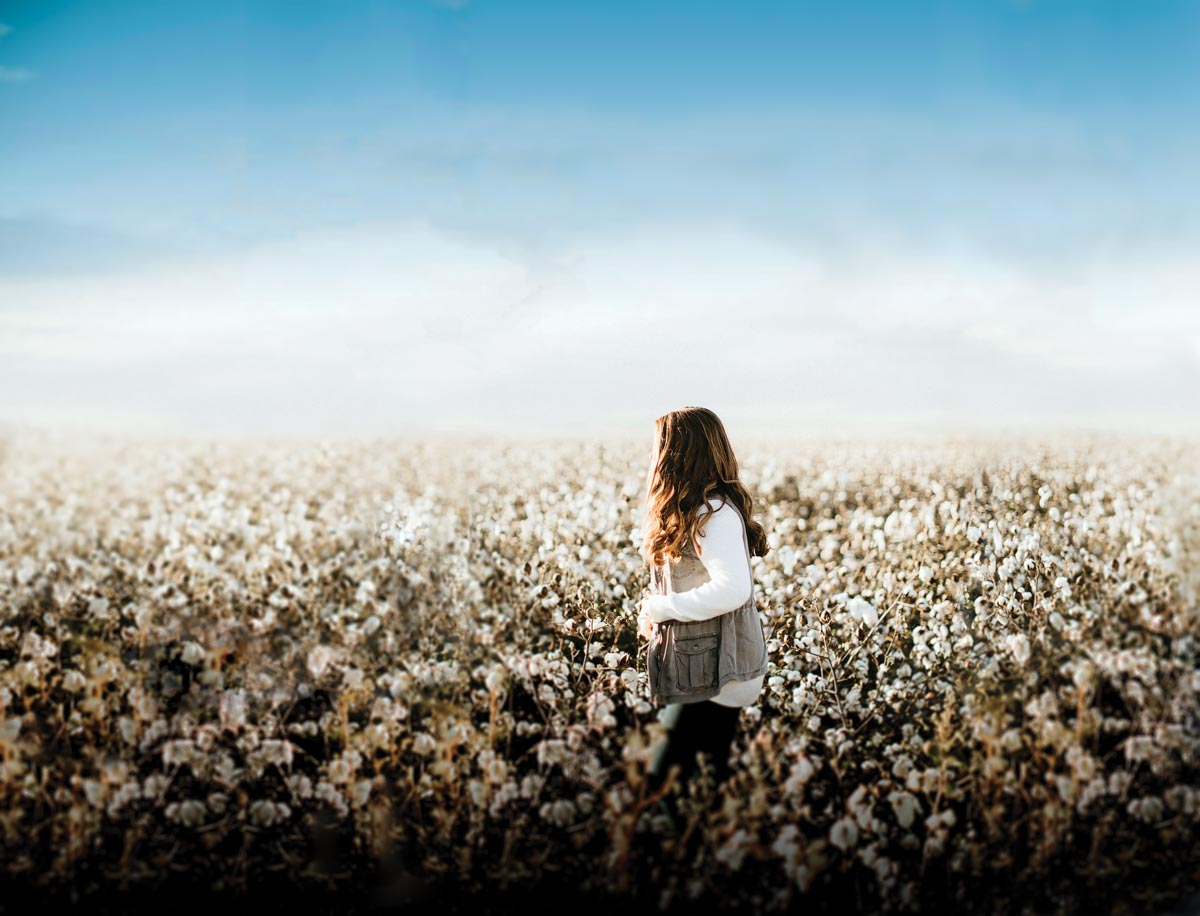As gardeners are getting ready to get their hands dirty, here’s how to replace non-native plants with natives, how to choose which plants, and how to find native substitutes for landscaping. Also find the top 10 performing native plants in Missouri.
What if monarch butterflies floated over that hard-to-mow corner of your high-maintenance lawn? Imagine songbirds flocking to the trees in your yard because they heard about that breakfast buffet of insects and worms in your flower garden.
Idyllic scenes, yes–but they needn’t be confined to the imagination, or to a conservation area or botanical center tended by professional gardeners.
By landscaping with native Missouri plants, gardeners with the palest of green thumbs can enjoy such views just like the pros, all while knowing they’ve done their part to nurture complex ecosystems.
Native plant landscaping can mean seeding a prairie planting instead of reseeding part of a lawn, or tucking bee balm or purple coneflower into a bed once claimed by hostas.
It can also be “as simple as planting a native plant in a container,” says Carol Davit, executive director of the Missouri Prairie Foundation. “You don’t have to have this huge property to make a difference.”
Why Native Plants?
It’s easy to appreciate the beauty of a redbud tree or a mass of wildflowers in the spring, yet the reasons native plants matter run deeper than aesthetics.
“Native plants feed and shelter insects and other wildlife that couldn’t survive without them,” says Michelle Bowe, a Missouri State University biology instructor and president of the Missouri Native Plant Society’s southwest chapter.
As a curator of more than 100,000 plant specimens at the Ozarks Regional Herbarium, Michelle chuckles about working with “basically dead plants” and her “brown thumb” for gardening.
She does have an educated eye for identifying many native plants, though, and notes that she’s seeing fewer of these specimens on visits to places such as Busiek State Forest and Wildlife Area in Christian County.
Where wildflowers such as trillium, Dutchman’s breeches, and a buttercup called hepatica once dotted the forest’s understory, Michelle and her students now also spot less-desirable chickweed and pinkish-purple henbit, an imported but now naturalized mint often found in lawns, fields, and along roadsides.
“In the years I’ve been going there,” she says of Busiek’s landscape, “it’s become degraded.”
Native plants predate European immigration to the United States. Plants from other parts of the world can become invasive in Missouri for a variety of reasons and can spread, choking out native species.
In the forest, for example, invasive henbit or bush honeysuckle leaf out early in the spring, blocking the sun’s rays from delicate native wildflowers, which keeps them from blooming, Michelle explains.
Invasive plants decrease biodiversity, too, she adds, because if native plants disappear from an area, so do the insects that eat them, along with the soil-enriching worms that munch on bug larvae.
“Whatever might eat the insects—woodpeckers are a good example of birds that eat insects—if their insects are gone, the woodpeckers are going to be gone, too,” Michelle says.
Many Missouri birds and bees—and butterflies—are selective native plant eaters, according to Carol Davit.
“Monarch butterfly caterpillars feed exclusively on the foliage of milkweed plants,” Carol says. “Yellow sulphur butterflies feed on partridge pea. And zebra swallowtail larvae feed on the foliage of pawpaws. So if we want to sustain the songbirds that we love, the monarch butterflies, and other insects, we must choose native plants in our areas.”
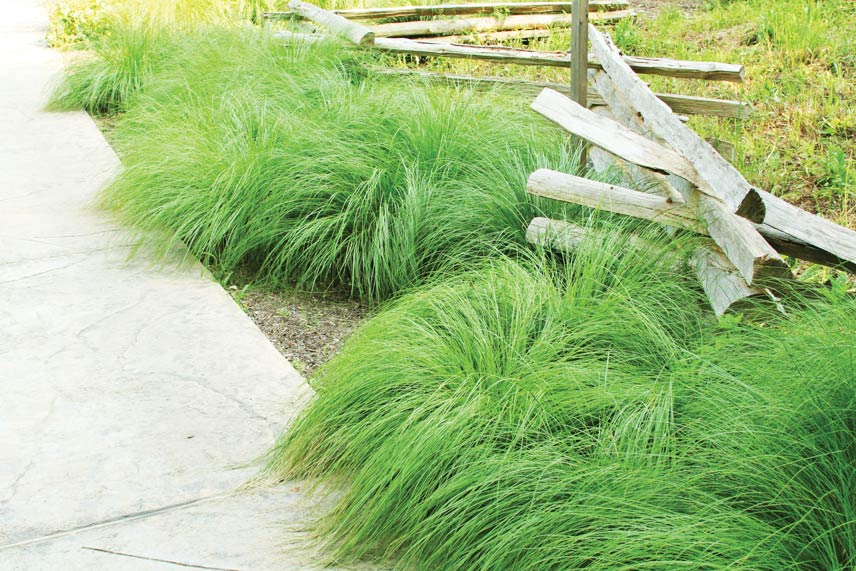
How to Replace Non-Natives
Landscaping with native flora that staked its claim long before the Louisiana Purchase takes planning, patience, and good, old-fashioned work.
Removing invasive plants is the first step. David Middleton’s eviction list includes everything from boxwood hedge and burning bush to Colorado blue spruce and Japanese silver grass.
“It’s a hard job,” says David, staff gardener for Springfield Botanical Gardens at Nathanael Greene/Close Memorial Park and co-owner with his wife, Jenny, of Ozark Soul Native Plants and Landscaping.
David advises gardeners to “go into the situation with a plan,” start small, and work in phases.
“For example, bush honeysuckle dug out from under trees will grow back if the space isn’t filled with a native plant right away,” he says.
Some small shrubs and trees he recommends are dogwoods, pawpaws, or redbuds. Planting a matrix of shade tolerant grasses, then burning them off every year until the honeysuckle seeds die, is another option.
David and Carol agree that fire is another way to kill non-native plants and seeds to prepare the soil for natives, but both urge gardeners to first check local ordinances and call their local fire departments.
To substitute a prairie planting for a lawn, kill the grass by applying herbicide or covering it with plastic sheeting, Carol suggests.
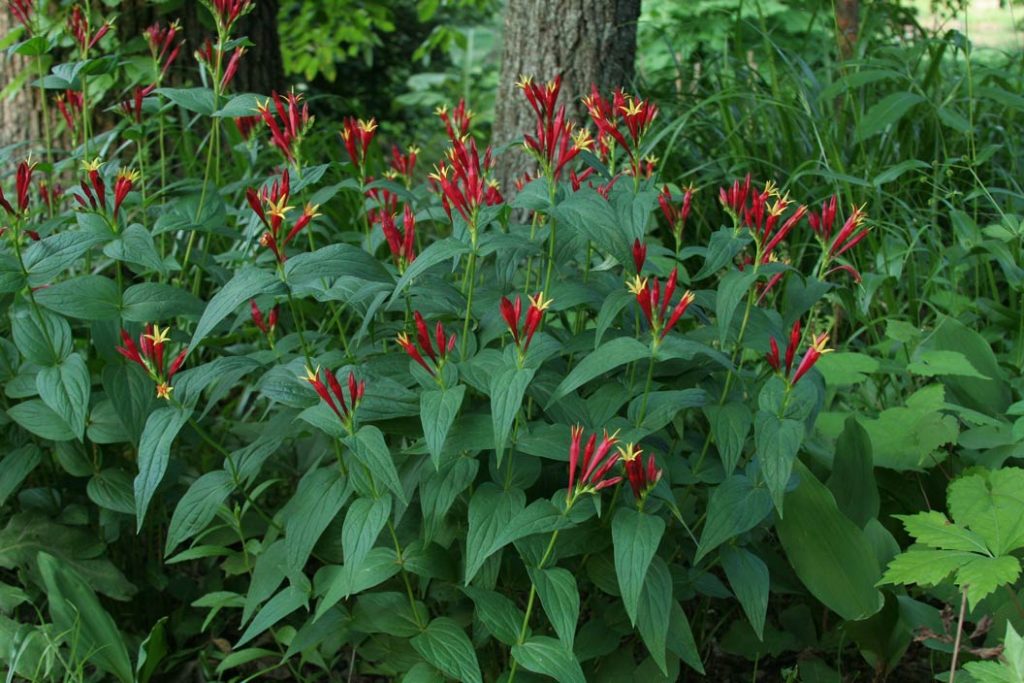
How to Choose Plants
Plant experts also say it’s wise to research the characteristics of native plants before working them into a landscape, especially in urban areas.
The tall, gray-headed coneflower—which actually boasts sunny yellow petals—may look majestic in nature yet rapidly tyrannize a border of fertilized garden soil, growing “like it’s on steroids,” David adds.
“It grows to six feet tall in the second year, and now it’s flopped down on your sidewalk and you’re wondering, ‘Well, I thought these native plants were going to be a good thing.’”
Likewise, Carol says, “I’m not suggesting planting eight foot- tall prairie grass in your front yard is a good idea.”
Along a walkway, plant native species that grow no more than 18 inches tall, David recommends.
“Cedar sedge is one of my favorites to landscape with,” he says. “It has a beautiful, beautiful texture, and it stays short, which is wonderful.”
Sedge also complements phlox and alumroot in Carol’s native woodland shade garden, planted under the canopy trees at her Jefferson City home.
On the other hand, a free-spirited prairie planting like the one along her driveway can keep anyone from becoming “an indentured servant” to a lawnmower. “If you have a really large acreage, instead of mowing all that, at least part of it could be converted to a planting of native grasses and wildflowers to benefit pollinators and butterflies,” Carol says.
“Although many envision such a natural landscape when they think of native plants, some can also be used in formal gardens,” says David, who gardened at the Shaw Nature Reserve near St. Louis for seven years before moving to the Ozarks.
To create a formal look, he says, choose three to five species and plant the same species en masse; for texture, consider the foliage of plants, including their fall colors. Something else to consider either for a natural or formal garden is when the native plants bloom.
“If you want to have a nice show of color throughout the growing season, it’s important to look at the bloom periods,” Carol says. “Again, it’s about more than aesthetics. In an undisturbed prairie, plants flowering at different times of the year provide pollen and nectar for pollinators like bees and moths. By selecting plants that are blooming throughout the growing season, we’re providing food sources for these insects.”
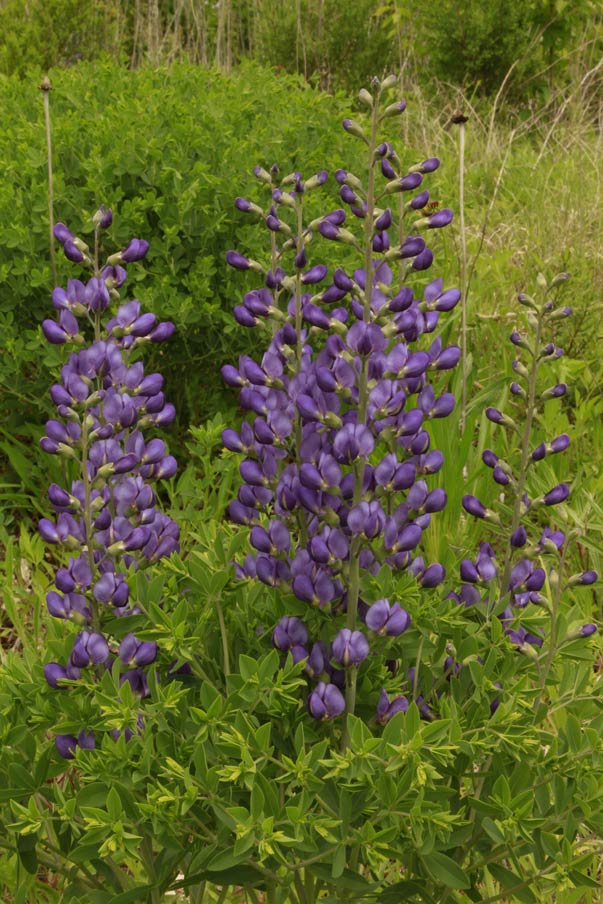
Patience and Work
Some may hesitate to landscape using seeds of natives because they establish slowly. For smaller gardens or a perennial bed, using plants rather than seeds is recommended. When using seeds, looks can be deceiving.
“The development of extensive roots is happening along with the growth of the above-ground part,” Carol explains. “It does that because the prairie plants are adapted to this part of the world, where it’s drier than the eastern deciduous forest. One of these adaptations is this deep root system to find water.”
David warns gardeners against planting natives too closely, assuming they will remain small. It’s a mistake that will “cause you more work in the end, because you’re going to be dividing them,” he says, recalling how a backhoe hit bedrock in an effort to remove a compass plant.
Another misconception is that native gardens are carefree. David notes they require maintenance chores—watering, weeding, dividing, and pruning.
Yet, the butterflies and songbirds that reward your landscaping efforts make it all worthwhile.
“If you pull out your boxwood hedge and your burning bush and your Colorado blue spruce and you put in a cherry, an oak, a willow, some coneflowers, some coreopsis, some blazing stars, you’re transforming your garden into an alive experience,” David says. “You’re not only looking at your garden. Now, you’re going to experience your garden.”
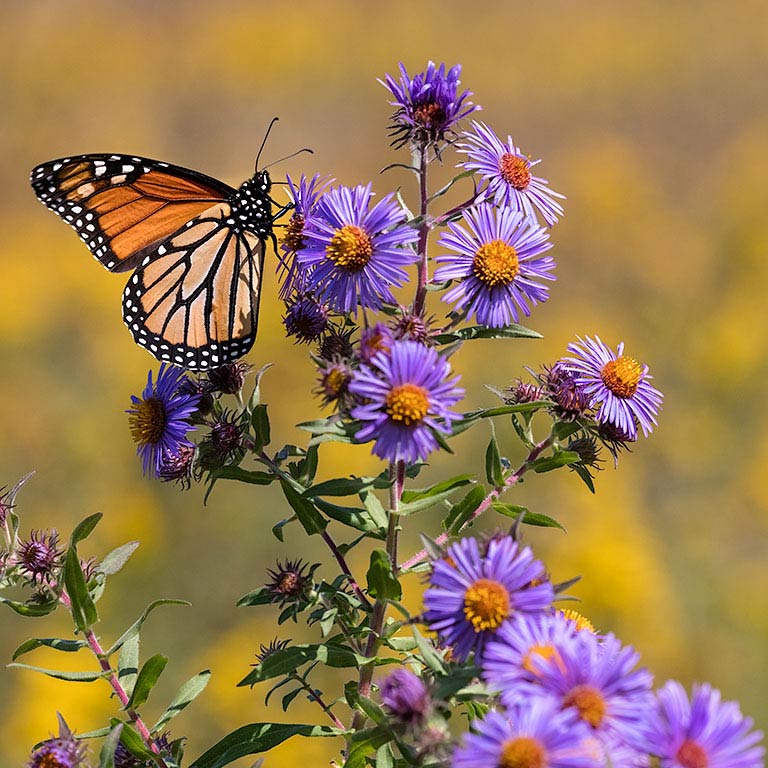
How to Find Native Substitutes For Landscaping
Digging native plants from the wild on private land without permission or on public land is illegal, and is discouraged. However, finding suppliers of these native plants is pretty simple. Great Missouri plant substitutes can be purchased almost anywhere in the state. For information on the more than 145 Grow Native! professional members, many of whom grow and sell native plants, seeds, shrubs, and trees—in Missouri and elsewhere in the lower Midwest—visit GrowNative.org and click on Resource Guide. The site has a map of retailers with native plants. Call the Missouri Prairie Foundation at 888-843-6739 for advice and suggestions.
Top 10 Performing Native Plants
Missouri has 2,000 plus native plants. Many can be used for specific landscaping purposes. The Missouri Prairie Foundation’s growth initiative Grow Native! program offers this list of top performing native plants. These 10 plants are all attractive, durable, long-lived, and compact.
- American beautyberry (Callicarpa americana)
- This 3- to 5-foot shrub has pink flowers in summer and purple berries in the fall.
- Aromatic aster (Symphyotrichum oblongifolium)
- Ranging from 2 to 3 feet tall, the aster sports lavender flowers in the fall and supports pollinators.
- Blue wild indigo (Baptisia australis)
- This 2- to 3-foot plant produces blue flower spikes in the spring and helps pollinators.
- Copper iris (Iris fulva)
- This 18- to 24-inch plant is great for rain gardens with its coppery red flowers between May and June.
- Indian pink (Spigelia marilandica)
- A 2-foot-tall woodland plant, it blooms in early summer with bright red and yellow flowers.
- Littleflower alumroot (Heuchera parvifora var. puberula)
- Growing to 1 foot, this fall-blooming plant with white flowers is suitable for small gardens since it is compact.
- Oak sedge (Carex albicans)
- A grass reaching 8 to 12 inches high, oak sedge has compact tufts and thrives in dry, shady areas.
- Orange coneflower (Rudbeckia fulgida var. umbrosa)
- The 1- to 2-foot-tall coneflower is great for rain gardens and works well as a ground cover.
- Prairie dropseed (Sporobolus heterolepis)
- Growing to 18 to 24 inches, this clump-forming grass is fine-textured and flourishes in full sun.
- Wild hydrangea (Hydrangea arborescens)
- A large 3- to 5-foot shrub, this plant is at home in sun or partial shade.
Here are just a few native plant vendors in Missouri:
- Missouri Wildflowers Nursery, at Jefferson City
- Ozark Soul, Thornfield, with events throughout the Ozarks
- Gaylena’s Garden, at Barnett
- Sunrise Gardens at Columbia
For specific landscaping needs, visit the Missouri Prairie Foundation’s Grow Native! website at GrowNative.org and search for Top Ten lists.
This article originally appeared in Missouri Life’s April 2018 issue, but was updated with the vendors in March 2023.
Related Posts
Bootheel Confidential: A Guide to Missouri’s Southland
The Bootheel is influenced more by Memphis than by St. Louis, and the area definitely is a member in good standing of the Old South. Stuck like a hatchet in the forehead of Arkansas, the Bootheel and its people, for the most part, feel alienated from the rest of Missouri.
Earthly Creations
They say that life is what happens while you’re busy making plans. We’re pretty sure you’d get no argument from Sandra Zak.
Angel Abroad
Whether she’s Europe or doing interviews with magazines like Vogue, Angel Olsen confounds people when they discover she’s from St. Louis.


